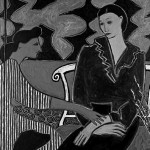by Florence Howe
Folks, This is What a Feminist Looks Like
Florence Howe on Grace Paley
I met Grace on marches and in political meetings in Cambridge in the 1960s. But our friendship grew specifically in relation to the Feminist Press. Her generosity was as boundless as her energy, and she spoke at fundraisers, signed fundraising letters, wrote blurbs for our books.
She also supported me personally. When she knew I was alone out in the Amagansett cottage and depressed, she called every day to ask what I was doing. Once, I replied that I was trying to get several mean blue jays to stop badgering a balding jay.
“Are you saying that you can tell one blue jay from another?” she asked.
“Yes, of course, they’re all different,” I responded.
“Well,” she said, “that calls for an assignment. You must write a poem about blue jays. I’ll call tomorrow, and you can read it to me.”
Addressing an audience, Grace strode energetically onto a platform, a middle-aged woman wearing a loose jacket over a midlength skirt or a pair of trousers. Her gray hair was unfashionably piled on her head. But her smile shone so that you could see it even from a back row. She’d begin by saying, “Folks, this is what a feminist looks like,” and the crowd would laugh and relax.
At the end of the 1980s, she came to see me, saying I could do something for her. She had a small collection of prose and poetry, along with paintings by Vera B. Williams, some of which were first published by the War Resisters League as a datebook called 365 Reasons Not to Have Another War. Vera’s paintings, Grace carefully explained, were not illustrations. They were antiwar art, just as the stories and poems were antiwar art. And they needed to be included in the volume, which she and Vera had worked on together. The problem was that most of the paintings were in color, and no publisher would take the volume on. It was a slim collection: Long Walks and Intimate Talks came to only 78 pages when the Feminist Press published it in 1991 in paperback, with a few hundred hardcover boxed volumes signed by Grace and Vera.
Until her very last days, Grace’s mind was clear. The cancer that had taken one breast had metastasized to her bones. On July 21, 2007, a month and a day before Grace’s death, I drove to Vermont to stay in Grace and Bob’s extra cottage. When I awoke the next morning, I found Grace just emerging in a bathrobe from her bedroom. She said she’d like to go for a walk, asking me to go with her. I assumed she meant around the property, perhaps into the woods behind the house, but when we stepped outside, she headed swiftly to her car. I was sure she was in no shape to drive and tried to get her to go in my car.
“No,” she said, “You don’t know the way.”
“Do you have your license with you?” I asked.
“No,” she said, “I don’t need it.”
For a second I assumed she would be stopped by the absence of keys, but she reached for them on the floor of the front seat. Impatient now, for I was still trying to delay her, Grace commanded, “Get in the car.”
I really began to worry when she took the curves on the hill much more swiftly than I would. When we emerged into traffic, my worry turned to fear, as she brazenly crossed lanes directly into the face of traffic. Once we were on small rural roads between great fields of grain, with no cars to dodge, I relaxed, simply watching Grace, who was clearly enjoying every moment. Just as I wondered whether we were lost, Grace uttered an “aha,” and we emerged onto a road filled with traffic that seemed to dissolve before her beat-up car. She parked in front of a huge farm stand and got out of the car, smiling and saying hello to people whom she greeted by name. She chose some vegetables, and then we walked into a coffee bar behind the farm stand, where we sat until she felt ill again and I suggested leaving. She drove back much more slowly and directly.
Several hours later, Bob told me that Grace was not allowed to drive, that her license had been taken away, that the police knew her, and that local drivers tried to stay out of her way. I didn’t suggest the obvious: keep the car keys in his pocket and not on the floor of the car.
Fifteen minutes later, Grace walked into the house, looking chipper and very pleased with herself, carrying a stack of mail and magazines. “Someone had to go to the post office,” she said as she went off to bed.
Florence Howe is the founding editor of the Feminist Press, which in 2011 will publish her memoir, A Life in Motion, from which this is adapted.
For more about Grace Paley, see Lilly Rivlin’s just-released docu- mentary film, “Grace Paley: Collected Shorts.” lillyrivlin.com
Unforgettable Friendships
The articles in this special section:
Balm in Gilead
Marcia Falk on Beth Uval
Click: Ignore
by Alice Sparberg Alexiou
An Ode to 40 Years: The Power of Women’s Friendship
by Rabbi Naamah Kelman and Nessa Rapoport
 Please wait...
Please wait...